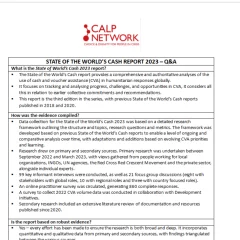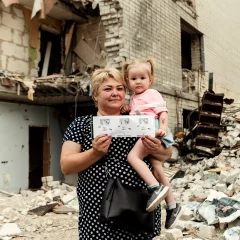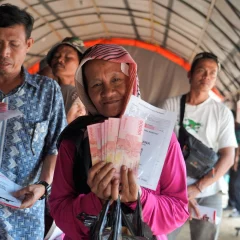Humanitarian cash assistance at a crossroads, warns new report

Humanitarian cash assistance at a crossroads, warns new report
Unlocking the potential of cash assistance to meet people’s humanitarian needs will require greater effort and change.
- In 2022, $7.9 billion was transferred as cash or vouchers to crisis-affected people – a 41 % increase from the year before.
- However, as a percentage of overall international humanitarian assistance the growth of Cash and Voucher Assistance (CVA) is relatively small. CVA accounts for 21% of international humanitarian assistance, an increase of 7% since 2017.
- There remains huge potential to increase the volume of CVA and to make it more people centred, but it will require concerted effort and change across the humanitarian system.
The latest State of the World’s Cash report, published by the CALP Network, highlights that the volume of cash and voucher assistance has grown dramatically, but it could be at risk of stalling.
Providing people with Cash and Voucher Assistance (CVA) during disasters and emergencies means that they can decide for themselves how to meet their needs in the face of crises. And a growing body of evidence supports the fact that people usually prefer to receive aid in this way.
The use of CVA has been widely hailed as a key component of more people-centred aid. In 2022, $7.9 billion dollars was transferred as cash or vouchers to crisis-affected people – a 41 % increase from the year before.
This is a huge change in humanitarian action given CVA as a form of humanitarian assistance is a relatively recent phenomenon. CVA only gained attention in the wake of the 2004 Tsunami, and then seeing a major increase in use following the World Humanitarian Summit in 2016.
CALP’s Director, Karen Peachey explains some of the reason behind this growth; “One – people prefer it. Cash in a crisis can mean the difference between getting what you want, or what someone else thinks you want. Two – humanitarian policies have gradually changed to support its increased usage. Three, it’s effective and can be rolled out relatively quickly, and efficiently: which is why we saw so many governments and humanitarian agencies around the world turning to cash as a central part of their response during the COVID-19 pandemic.”
However, looking at the growth of CVA in dollar terms alone doesn’t provide the full picture: It’s true that CVA volume has increased, but so too has overall humanitarian assistance. In percentage terms the growth does not look so impressive. Currently CVA accounts for 21% of international humanitarian assistance, an increase of 7% since 2017. Yet, research shows that if used whenever and wherever appropriate it could form up to 50%.
So why does CVA not make up a larger proportion of overall aid? According to the report the answer lies in standing back and looking at the whole picture – the CVA ecosystem is large and complex – every percentage point increase in the use of CVA needs multiple changes within organisations, with changes to systems, skillsets, and ways of thinking. Added to that, there are changes needed between organisations – who does what, how they work together and how they coordinate.
CVA is not an island – it exists as part of the wider humanitarian system which itself sits within financial, political and other systems, all of which offer incentives as well as barriers to change. What’s clear is that the use of CVA can increase, as research shows and, indeed, as the response during COVID-19 demonstrated. Yet, after the COVID-19 response its use slipped back – the reasons for that are harder to unpack.
Peachey continues; “The truth is that systemic change takes time. After making the big commitments that offer a vision of change, it’s then about changing mindsets across many teams and altering a myriad of systems and processes. And this needs to happens not just in one organisation – but in every single organisation that makes up the humanitarian system. Translating commitments into system wide change is not simple.”
The report also offers solutions towards a more rapid and decisive growth in CVA. For example, stronger linkages between CVA and other forms of financial assistance, including social protection, offer the potential for greater efficiency and effectiveness.
Social protection systems, (which are normally led by governments), help people to cope with crises and shocks, find jobs, invest in the health and education of their children, and protect the vulnerable populations. The possibility to link CVA more closely to these mainstream systems represents huge opportunities for growth. The report stresses that it’s not a simple ‘fix’ and won’t be appropriate in all situations, but if investments are made this could lead to a break-through. There are gains to be made in many other areas too.
The volume of CVA (i.e., the amount of money transferred to people in crisis) is not the only issue. Improvements are also needed in terms of quality. Peachey explains; “It’s no good providing vouchers if people prefer cash, or providing cash in a way people don’t like. We need to be thinking more about quality from the perspective of people on the receiving end of assistance not just the metrics of organisations.” The report highlights good practices around quality, such as co-designing programmes alongside people in crisis, and basing programme design on a robust understanding of the context. It highlights that to reach the most vulnerable 20% of people, CVA must be specifically tailored to meet their needs and help connect them with other services as required. Peachey adds, “There’s need for flexibility – a one-size-fits-all approach does not work. People are different. Contexts are different. Preferences vary. As humanitarians we must remain willing to innovate and adapt programmes based on what crisis-affected people tell us. There is so much good practice already out there, but also much to reflect on”.
Finally, the report sounds an alarm bell against the risk of complacency: There remains huge potential to increase the volume of CVA and to make it more people centred. Some feel that the use of CVA is now accepted and the ‘battle is won’. This is risky. CVA will not reach its potential unless further, substantive, changes are made to the underlying structures, mindsets, and day to day processes of the humanitarian system. This requires ongoing collective effort and commitment from all stakeholders.
The State of World’s Cash 2023 provides a neutral, authoritative, and insightful picture of the humanitarian sector. It provides a compelling message to all humanitarians to work collectively towards an increase in the use and quality of CVA, to improve aid effectiveness, and increase choice and dignity for people in crisis.
ENDS
For further information or to arrange an interview please contact Jo-Anne Witcombe.
The CALP Network is a dynamic global network of over 90 organizations engaged in the critical areas of policy, practice and research in humanitarian Cash and Voucher Assistance (CVA) and financial assistance more broadly. Collectively, CALP members deliver the vast majority of humanitarian CVA worldwide.
The CALP Network exists to maximize the potential that humanitarian cash and voucher assistance (CVA) can bring to people in contexts of crisis, as one component of broader financial assistance. CALP envisions a future where people are enabled to overcome crises with dignity, by exercising choice and their right to self-determination in order to achieve long term well-being. Our role as a collective is to optimize the quality and scale of humanitarian CVA by generating alignment in the approaches and actions of those within and across our network.
What makes the CALP Network unique is its diversity. CALP members currently include local and
international non-governmental organizations, United Nations agencies, the Red Cross/Crescent
Movement, donors, specialist social innovation, technology and financial services companies, researchers and academics, and individual practitioners.
Together we seek to better meet the needs and improve the outcomes for people affected by crisis. To do this we ensure that CVA is a central, scalable component of quality, timely and appropriate humanitarian assistance, and that the need to sustain positive outcomes for people over the longer term is considered.
The State of the World’s Cash report is published by the CALP Network and provides comprehensive and authoritative analyses of the use of cash and voucher assistance in humanitarian responses globally. This 2023 report is the third iteration in the series, with previous editions published in 2018 and 2020.
This report details progress and challenges and identifies what needs to happen to achieve better CVA. Fundamentally, this report is about how to design and deliver better aid.
The State of the World’s Cash report 2023 is packed with analysis and reflections; it pulls together the views of people involved in CVA policy and practice from around the world; synthesizes research from the last three years; and cross references findings with what the evidence tells us about the perspectives of people in crisis. The report finds that substantive changes have taken place in some areas, with little or no movement in others.
With a wealth of information, this neutral and authoritative report is for anyone, and everyone involved in CVA, from policy makers, practitioners, donors, and academics to CVA champions and advocates. It can be used to inform strategic thinking, influence policy, and act as a reference point for those seeking to deepen their understanding of CVA trends.
It is a data-rich resource with the key arguments and recommendations needed to inform progress towards more effective and people-centred aid.
Media assets
Please find a range of resources to complement the press release.
-

We've compiled a list of frequently asked questions, with answers, in this document.
We've compiled a list of frequently asked questions, with answers, in this document.
-

Image caption: In partnership with ADRA, WFP value vouchers are given to war-affected people in Chernihiv city. The voucher enables the holder to purchase food and non-food items from specific shops. © ADRA Photolibrary/WFP. August 2022
Image caption: In partnership with ADRA, WFP value vouchers are given to war-affected people in Chernihiv city. The voucher enables the holder to purchase food and non-food items from specific shops. © ADRA Photolibrary/WFP. August 2022
-

Image caption: Indonesian Red Cross (Palang Merah) and IFRC provided cash assistance to people affected by the earthquake that hit West Java, Indonesia in the Cianjur province in 2022. © The Indonesian Red Cross Society. May 2023
Image caption: Indonesian Red Cross (Palang Merah) and IFRC provided cash assistance to people affected by the earthquake that hit West Java, Indonesia in the Cianjur province in 2022. © The Indonesian Red Cross Society. May 2023
-

Image caption: Ghulam Mustafa is based in Sanghar, Sindh. Pakistan. He has set up a small roadside shop using the multi-purpose cash that he received from Oxfam. Ghulam says that many people in the area have used some of the support they have received to set up small businesses. © Tooba Niazi/Oxfam. April 2023
Image caption: Ghulam Mustafa is based in Sanghar, Sindh. Pakistan. He has set up a small roadside shop using the multi-purpose cash that he received from Oxfam. Ghulam says that many people in the area have used some of the support they have received to set up small businesses. © Tooba Niazi/Oxfam...